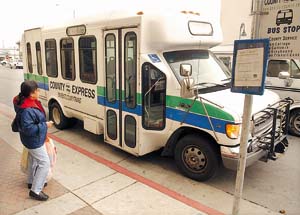The county’s economic czar calls COG’s use of $374,000 in
federal stimulus money toward purchase of two replacement buses
”
a positive step forward
”
while a spokesman for an influential tax watchdog group says it
is
”
probably not the best investment
”
to stimulate the economy in the short term.
HOLLISTER
San Benito County transportation officials have slated $374,000 of the $1.2 million headed to the area from the federal stimulus package toward the purchase of two new buses for transit routes to replace two others with high mileage.
A transportation official with the Council of San Benito County Governments responded, when asked how it would stimulate the economy as intended in the $787 billion legislation, by noting how the cutaway buses will service college students and people who go to work. The buses set for replacement have surpassed the 200,000-mile mark.
“Yes,” said Lisa Rheinheimer, COG’s executive director, “in the sense that our services for County Express – it is not only serving college kids, we are servicing people that use the bus to go to work.”
She added that these buses will work toward preservation of current jobs.
“Without these buses, some people couldn’t go to work,” she contended.
Economic Development Corp. of San Benito County President and CEO Nancy Martin shared a similar view on the bus replacement as Rheinheimer. She said that if the buses need to be switched out, it should be done so that people can get to work.
“What happens when these buses break down and people can’t get to work?” she said.
Martin said replacing the buses is a positive step forward.
“Anytime you can better the environment we operate in, I think that’s a good thing,” she said. “The main thing is to utilize the money and better the community, if it enhances the community and people getting to work.”
Not everyone agrees with Rheinheimer and Martin’s assessments of COG’s decision to buy the buses to stimulate the local economy.
Kris Vosburgh, executive director of the Howard Jarvis Taxpayers Association, said buses are probably not the best investment for the county, but that taxpayers will get something in return.
“It’s not to say that it doesn’t benefit,” he said. “Instead, they are focusing on things that won’t have an immediate impact.”
He said he is “not outraged” but also that it is a “sad commentary on the attempts to revive the economy.”
“It is not an economic stimulus,” said Vosburgh, from the Los Angeles-based group.
Vosburgh provided another possibility to stimulate the economy.
“If they want to recover from the recession, they should have first thought of cutting taxes,” he said. “The workers would see more money in their pockets. They would go out and spend it. You would have seen more money spent in these businesses.”
San Benito County’s $1.2 million – the remainder is headed toward road improvements – is the first of two installments from the recently approved federal package. An amount for the second installment is unclear at this point but would be slated to fund projects including guardrail replacement, chip seal work and adding bike lanes on San Juan Highway for the county, LED streetlight replacement for Hollister and street repairs for San Juan Bautista.
County Supervisor Anthony Botelho, also a COG board member, said he wants to use the money in whatever fashion is allowed and he emphasized his goal is to keep “as much of the money as possible” in the area.
“If there is an opportunity to update the fleet of buses, in the long run, it will be a benefit for the transit system,” Botelho said. “The only thing I can gather from that is that A, if we don’t utilize that money, somebody else will, and B, perhaps it’s a stimulus to make more buses in Detroit or something.”
In the first tier of spending, along with the $374,000 on new buses, the agency is scheduled to allocate $811,000 to both the City of Hollister and San Benito County for road improvements. Related projects are required to start within 120 days, she said. The second tier projects are projects, then, would be ready to begin in August 2010.
Officials have noted how much of the road work will be street overlay and maintenance jobs such as fixing potholes.
Martin said that due to the criteria for the money, people are scrambling to find shovel-ready projects.
“There is a lot of criteria to use that money, we’re finding across the board,” Martin said. “(We need to look at) what will be most beneficial and how we can utilize this money.”
Another challenge with some shovel-ready projects is the need for environmental review, Martin said.
“It can take a long time,” she said, adding that a project requiring a review of that kind can take months to process.
In terms of job creation, Rheinheimer said that according to the Federal Highway Administration, for every billion dollars spent on transportation, 18,000 jobs would be created. In the county, that would amount to around 24 or 25 jobs, in theory.
Phone calls placed to Sen. Barbara Boxer’s Washington D.C. spokeswoman’s office were not immediately returned before publication.
To ask questions or make comments to COG, e-mail the agency at in**@**********og.org. To write to individual board members, go to www.sanbenitocog.org/board_members.php and click on the member’s name for an e-mail address.
For an expanded version of this story, go to www.freelancenews.com Friday.
Free Lance Editor Kollin Kosmicki contributed to this report.









